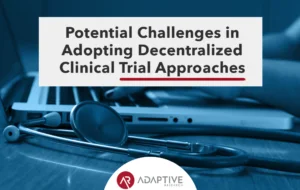Virtual visits (e.g., emails, phone calls, and videoconferencing) allow participants to interact with their trial team without the need for face-to-face meetings. They can be used in various settings but are frequently implemented to minimize travel requirements—for example, patients living in remote areas far from clinical centers. Or locations where frequent travel may present logistical challenges, such as international studies involving multi-country sites. Virtual contact is also increasingly being used in place of physical site visits to support the process of receiving informed consent and determining patient eligibility. Virtual contact is often combined with real-time technologies such as Web cameras and electronic patient diary apps to collect data.
Virtual visits are becoming increasingly common in clinical research, but can they be implemented effectively?
The CTTI launched a multi-stakeholder, decentralized clinical trial addressing the best ways to implement remote patient data collection and monitoring — and provided researchers and regulators with the tools they need to support this new approach.
At any rate, because of these combined factors, everyone involved in clinical research must understand how virtual visits work, their benefits and drawbacks, and what steps need to be taken to ensure that trials involving virtual visits adhere to ethical guidelines […] Virtual contact can take place either synchronously (e.g., using real-time technologies, such as web cams), or asynchronously (e.g., through electronic diaries).
Benefits of Virtual Visits
Virtual contact can bridge geographical or organizational gaps in clinical trials and has been used in a wide range of therapeutic areas [5, 6]. Examples include psychiatric [7], oncology [8], and cardiovascular studies [9], as well as infectious disease research with tuberculosis and HIV cohorts.
Virtual visits may also be efficient when patients are experiencing severe symptoms that prevent travel to the clinic, such as most recently with the pandemic. Virtual visits support all stages of clinical trial development, from protocol development to patient recruitment and data collection. This allows efficiency gains for later-stage research such as long-term observational cohort studies where virtual visits provide an enabling means of patient follow-up.
Other benefits to virtual visits include:
- Identification of areas that currently have no health care access or quality health care services
- Development of programs targeted to fill service gaps by providing virtual visit technology
- Promotion of the successful operation and expansion of existing telemedicine programs through funding research and development; education; training; information sharing; technical support resources; financial incentives like loan guarantees or grants to promote broadband deployment in these areas; and the provision of seed money to fund pilot projects
- Maximizing efficiencies in current health care programs by preventing duplication and overlap in services, reducing administrative costs, and streamlining processes
- Decreased patient travel time allowing for more face-to-face time with providers when appropriate
The Importance of Data Security and Patient Privacy
The Health Insurance Portability and Accountability Act (HIPAA) and the Health Information Technology for Economic and Clinical Health (HITECH) Act ensure the privacy and security of certain health information. HIPAA protects the privacy, security, and transmission of individually identifiable health information.
Under HIPAA, covered entities must conduct a risk analysis to identify potential risks to patient privacy. Once risks are identified, covered entities must implement reasonable safeguards that protect the confidentiality of PHI. Additionally, these entities will also monitor an information system’s vulnerability if it could result in unauthorized access or modification to patient data.
If healthcare providers do not follow the rules for privacy protection, the consequences could be dire, whether by accident or on purpose. According to the HHS, covered entities that violate HIPAA are subject to extensive civil and criminal penalties.
The U.S. Department of Health and Human Services (HHS) recently released guidance for healthcare providers on how to protect patient data in virtual visits, which has become an increasingly popular way for consumers to communicate with their doctors via technology.
Conclusion
Virtual visits (also known as telemedicine, e-visits, or virtual care) are becoming more widely used. Virtual visits use technology, including electronic communications such as email, chat, and social media, to provide healthcare services. The convenience of virtual visits allows consumers to communicate with their doctor from the comfort of their own home rather than having to visit an office to complete a check-up.
At the same time, the use of virtual visits could present data security challenges because consumer health information (CHI) is transmitted electronically and may be stored across multiple devices. Virtual visits bring new complexities for protecting CHI—such as where this information can be stored and how it can be shared.
Adaptive Research can assist your team with the clinical trial process from start to finish. Adaptive Research offers various services designed to streamline the process and enhance your experience working with a CRO.






